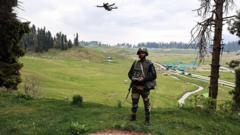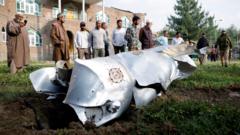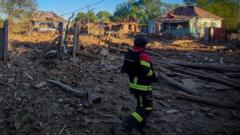The current India-Pakistan standoff reflects historical anxieties while confronting a modern landscape of advanced warfare and pervasive misinformation.
Tensions Surge in India-Pakistan Conflict: A Personal Reflection

Tensions Surge in India-Pakistan Conflict: A Personal Reflection
As the longstanding rivalry flares up, a journalist recalls the emotional echoes of war and the new challenges of reporting the crisis amid disinformation.
In the early hours of May 9, 2025, the conflict between India and Pakistan has reached an unprecedented peak, particularly in the contentious region of Kashmir. The echoes of 1971 resonate strongly for many, including seasoned journalist Hari Kumar, who recalls the palpable tensions of his youth during the last significant declared war between these neighboring nations.
Back in seventh grade, Kumar vividly remembers the air raid sirens, power blackouts, and the collective anxiety that hung over his community. Today, as the two countries exchange fire, he observes that while the tactical elements of warfare have evolved—introducing drones and missiles that strike deep into populated areas—the psychological landscape remains similarly fraught with fear and uncertainty.
The primary transformation, Kumar notes, is the overwhelming flood of misinformation on social media which complicates the reporting landscape. As he navigates through this modern chaos, the sense of panic among civilians grows, challenging journalists to discern fact from the haze of competing narratives.
While nationalism flares up as it did decades ago, societies have changed drastically. In the ‘70s, India was largely agrarian and economically challenged, relying on grassroots support for the military. Now, as the fifth-largest economy globally, India’s technological progress brings both accountability and threats, with sophisticated weaponry amplifying the risks of escalation.
Kumar, stationed in New Delhi and boasting over two decades of journalistic experience, emphasizes how these advancements have reshaped the battlefield, making every part of both nations potential warzones. As international observers look on, the need for clarity and truth amid confusion has never been more critical in this ongoing geopolitical dispute.
Back in seventh grade, Kumar vividly remembers the air raid sirens, power blackouts, and the collective anxiety that hung over his community. Today, as the two countries exchange fire, he observes that while the tactical elements of warfare have evolved—introducing drones and missiles that strike deep into populated areas—the psychological landscape remains similarly fraught with fear and uncertainty.
The primary transformation, Kumar notes, is the overwhelming flood of misinformation on social media which complicates the reporting landscape. As he navigates through this modern chaos, the sense of panic among civilians grows, challenging journalists to discern fact from the haze of competing narratives.
While nationalism flares up as it did decades ago, societies have changed drastically. In the ‘70s, India was largely agrarian and economically challenged, relying on grassroots support for the military. Now, as the fifth-largest economy globally, India’s technological progress brings both accountability and threats, with sophisticated weaponry amplifying the risks of escalation.
Kumar, stationed in New Delhi and boasting over two decades of journalistic experience, emphasizes how these advancements have reshaped the battlefield, making every part of both nations potential warzones. As international observers look on, the need for clarity and truth amid confusion has never been more critical in this ongoing geopolitical dispute.

















